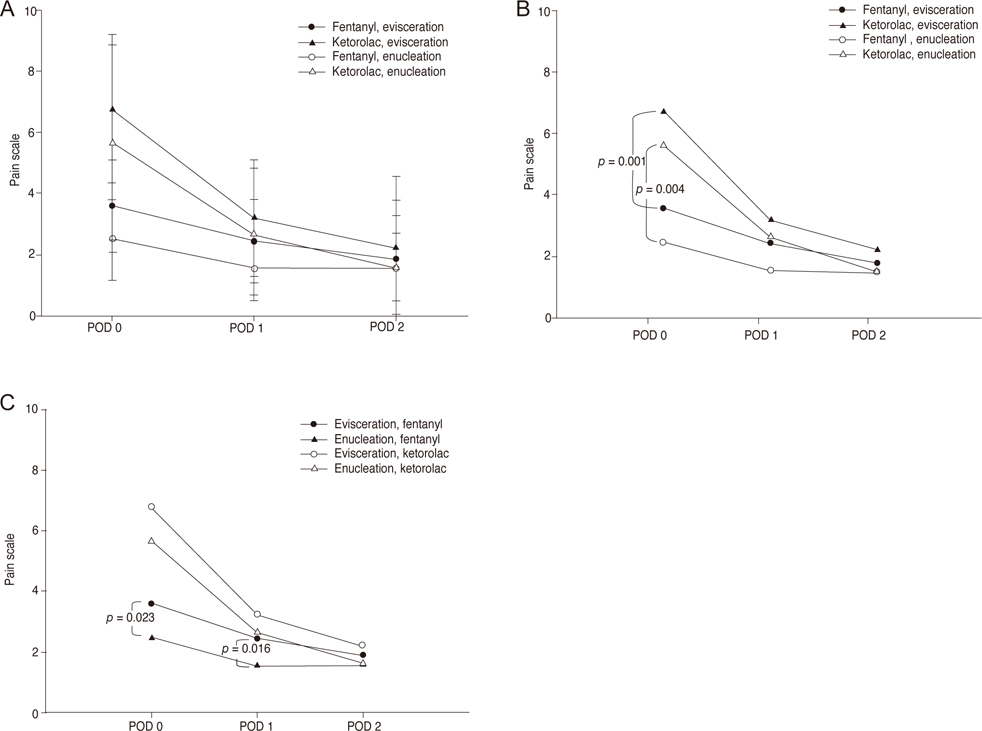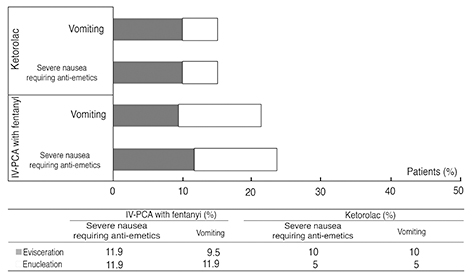Korean J Ophthalmol.
2013 Aug;27(4):229-234. 10.3341/kjo.2013.27.4.229.
Comparison of Pain-relieving Effects of Fentanyl versus Ketorolac after Eye Amputation Surgery
- Affiliations
-
- 1The Institute of Vision Research, Department of Ophthalmology, Yonsei University College of Medicine, Seoul, Korea. yoonjs@yuhs.ac
- 2Department of Ophthalmology, Soonchunhyang University Bucheon Hospital, Soonchunhyang University College of Medicine, Bucheon, Korea.
- 3Heukseok Yonsei Eye Clinic, Seoul, Korea.
- KMID: 1705417
- DOI: http://doi.org/10.3341/kjo.2013.27.4.229
Abstract
- PURPOSE
To investigate the analgesic effect and incidence of postoperative nausea and vomiting (PONV) between the opioid fentanyl and the non-steroidal anti-inflammatory drug ketorolac in patients who underwent eye amputation surgery.
METHODS
Retrospective observational case series. Eighty-two patients underwent evisceration or enucleation surgery by one surgeon over a 2-year period. Fentanyl by intravenous patient-controlled analgesia (IV-PCA) at 20 microg/kg with 12 mg/kg ondansetron or intravenous ketorolac at 2 mg/kg/day was administered to patients at postoperative days 0, 1, and 2. The pain score was measured using an 11-point visual analog scale (VAS). The incidence of severe nausea requiring anti-emetics and the incidence of vomiting were reviewed.
RESULTS
The mean postoperative VAS in the fentanyl group was significantly lower than that in the ketorolac group on the day of operation for both types of surgery (p = 0.001 and p = 0.004, respectively). At postoperative days 1 and 2, the mean VAS was not different between the two groups for either surgical type (p > 0.05 for both days). The mean VAS was significantly higher in eviscerated patients than in enucleated patients at postoperative days 0 and 1 in the fentanyl group (p = 0.023 and p = 0.016, respectively). However, this was not observed in the ketorolac group. The incidence of PONV was higher in the fentanyl group than in the ketorolac group, although this was not statistically significant for either surgical type (p > 0.05 for both groups).
CONCLUSIONS
Fentanyl was more effective as an analgesic than was ketorolac on the day of operation for both surgical types. There was no difference between the two analgesics on postoperative day 1. The analgesic effect of fentanyl in enucleated patients was significantly higher than in eviscerated patients at postoperative days 0 and 1. The use of fentanyl by IV-PCA was associated with greater PONV despite co-administration with anti-emetics, although this finding was not significant.
MeSH Terms
-
Adolescent
Adult
Aged
Aged, 80 and over
Analgesics, Opioid/therapeutic use
Anti-Inflammatory Agents, Non-Steroidal/therapeutic use
*Eye Enucleation
*Eye Evisceration
Female
Fentanyl/*therapeutic use
Humans
Ketorolac/*therapeutic use
Male
Middle Aged
Pain, Postoperative/*drug therapy
Retrospective Studies
Treatment Outcome
Young Adult
Analgesics, Opioid
Anti-Inflammatory Agents, Non-Steroidal
Fentanyl
Ketorolac
Figure
Reference
-
1. Nakra T, Simon GJ, Douglas RS, et al. Comparing outcomes of enucleation and evisceration. Ophthalmology. 2006; 113:2270–2275.2. Yen KG, Elner VM, Musch DC, Nelson CC. Periocular versus general anesthesia for ocular enucleation. Ophthal Plast Reconstr Surg. 2008; 24:24–28.3. Giligson A, Dolman PJ, Buffam F. Comparison of retrobulbar analgesics for evisceration. Ophthal Plast Reconstr Surg. 2002; 18:258–260.4. Peng PW, Sandler AN. A review of the use of fentanyl analgesia in the management of acute pain in adults. Anesthesiology. 1999; 90:576–599.5. Ghodse AH, Edwards RE. Opioid analgesics and narcotic antagonists. Side Eff Drugs Annu. 1999; 22:97–106.6. Patanwala AE, Keim SM, Erstad BL. Intravenous opioids for severe acute pain in the emergency department. Ann Pharmacother. 2010; 44:1800–1809.7. Fero KE, Jalota L, Hornuss C, Apfel CC. Pharmacologic management of postoperative nausea and vomiting. Expert Opin Pharmacother. 2011; 12:2283–2296.8. Gan TJ, Meyer T, Apfel CC, et al. Consensus guidelines for managing postoperative nausea and vomiting. Anesth Analg. 2003; 97:62–71.9. Song JW, Park EY, Lee JG, et al. The effect of combining dexamethasone with ondansetron for nausea and vomiting associated with fentanyl-based intravenous patient-controlled analgesia. Anaesthesia. 2011; 66:263–267.10. Johnston KD, Quinlan J. The effect of combining dexamethasone with ondansetron for nausea and vomiting associated with fentanyl-based intravenous patient-controlled analgesia. Anaesthesia. 2011; 66:840–841.11. McDowell I. Measuring health: a guide to rating scales and questionnaires. 3rd ed. New York: Oxford University Press;2006. p. 477–482.12. Yoon JS, Lew H, Kim SJ, Lee SY. Exposure rate of hydroxyapatite orbital implants: a 15-year experience of 802 cases. Ophthalmology. 2008; 115:566–572.e2.13. Yoon JS, Lew H, Kook KH, Lee SY. The use of autogenous sclera as wrapping material in hydroxyapatite implantation. Ophthalmologica. 2009; 223:7–11.14. Walder B, Schafer M, Henzi I, Tramer MR. Efficacy and safety of patient-controlled opioid analgesia for acute postoperative pain: a quantitative systematic review. Acta Anaesthesiol Scand. 2001; 45:795–804.15. Ballantyne JC, Carr DB, Chalmers TC, et al. Postoperative patient-controlled analgesia: meta-analyses of initial randomized control trials. J Clin Anesth. 1993; 5:182–193.16. Koivuranta M, Laara E, Snare L, Alahuhta S. A survey of postoperative nausea and vomiting. Anaesthesia. 1997; 52:443–449.17. Apfel CC, Laara E, Koivuranta M, et al. A simplified risk score for predicting postoperative nausea and vomiting: conclusions from cross-validations between two centers. Anesthesiology. 1999; 91:693–700.18. Sinha VR, Kumar RV, Singh G. Ketorolac tromethamine formulations: an overview. Expert Opin Drug Deliv. 2009; 6:961–975.19. Kim SY, Kim EM, Nam KH, et al. Postoperative intravenous patient-controlled analgesia in thyroid surgery: comparison of fentanyl and ondansetron regimens with and without the nonsteriodal anti-inflammatory drug ketorolac. Thyroid. 2008; 18:1285–1290.20. Calenda E, Retourt A, Muraine M. Is evisceration of the eye more painful than enucleation? Eur J Anaesthesiol. 1999; 16:117.21. Tramer MR, Reynolds DJ, Moore RA, McQuay HJ. Efficacy, dose-response, and safety of ondansetron in prevention of postoperative nausea and vomiting: a quantitative systematic review of randomized placebo-controlled trials. Anesthesiology. 1997; 87:1277–1289.22. Gan TJ, Ginsberg B, Glass PS, et al. Opioid-sparing effects of a low-dose infusion of naloxone in patient-administered morphine sulfate. Anesthesiology. 1997; 87:1075–1081.
- Full Text Links
- Actions
-
Cited
- CITED
-
- Close
- Share
- Similar articles
-
- A Comparison of Butorphanol and Fentanyl Administered in Conjuction with Ketorolac in Intravenous Patient Controlled Analgesia after Total Abdominal Hysterectomy
- A Comparison of Fentanyl and Meperidine as Utilized in Patient Controlled Analgesia after Total Abdominal Hysterectomy
- The Analgesic Efficacy of Transdermal Fentanyl Patch with Intravenous Ketorolac by Patient Controlled Analgesia after Total Abdominal Hysterectomy
- Oxycodone versus Fentanyl for Intravenous Patient-Controlled Analgesia after Laparoscopic Gynecologic Surgery
- A Comparative Efficacy of Propacetamol and Ketorolac in Postoperative Patient Controlled Analgesia



